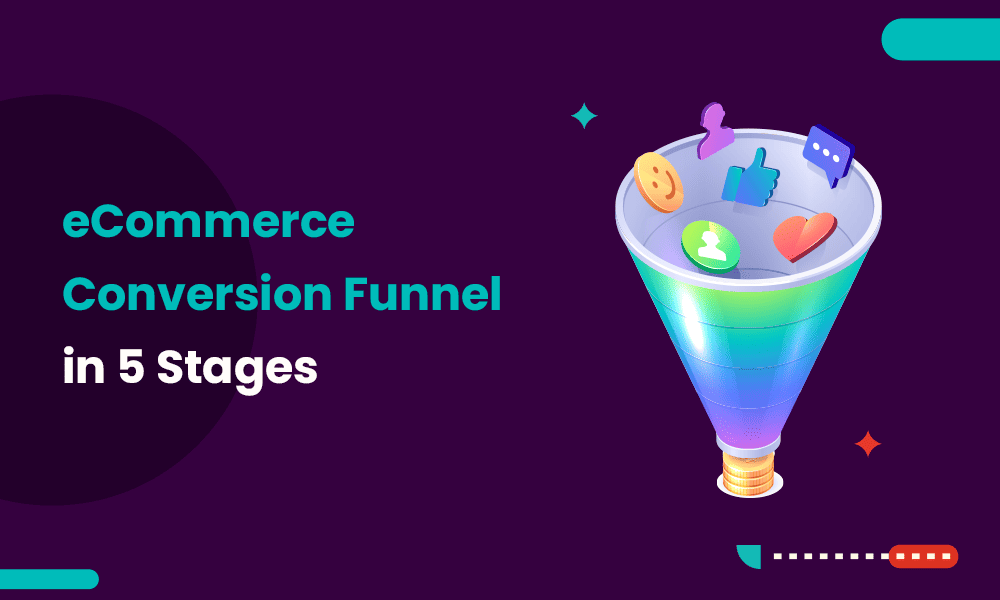Sales funnels are a valuable tool in that they guide customers through various predictable stages, starting as a lead and concluding as a loyal purchasing customer.
Today, we’re going to introduce the eCommerce conversion funnel, define what a conversion funnel is, and go through all the stages of the funnel so you can recreate your own.
Table of Contents
What Is an eCommerce Conversion Funnel?
Let’s begin, as promised, with a definition. Exactly what is an eCommerce conversion funnel, anyway?
Referred to as a sales funnel, a conversion funnel is an overview of the steps that an average customer takes when completing an eCommerce purchase.
Like a traditional sales funnel, the conversion funnel begins with a lead landing on your website and includes all the stages through to conversion.
In the world of eCommerce, a customer’s purchasing decisions aren’t always quite as linear as a conversion funnel might suggest, but it’s still good to have one of these funnels in place anyway to act as the benchmark for understanding lead and customer behavior.

Read also: Marketing Automation Funnel Explained For Beginners
The Stages of an eCommerce Conversion Funnel
The average eCommerce conversion funnel is divided into five steps or stages. Let’s take a look at each now.
Stage 1 – Discovery
Like most sales funnels, an eCommerce conversion funnel begins with the discovery stage. You can also think of this as the awareness stage, which is another nickname for this level of the sales funnel.
At this introductory stage, a lead has found your eCommerce brand, either completely by accident or through the targeted advertising and marketing campaigns you’ve launched as of late.
The lead will often find themselves on your website or your landing pages. Perhaps they even end up on your social media pages. They’ve never heard of you before, or if they have, they know very little about you.
This stage isn’t about researching or even thinking about a purchasing decision yet; that’s still many stages away. Instead, it’s all about building that awareness of your eCommerce brand.
At this stage in the funnel, you want to understand how these leads are finding you by issuing surveys. This way, you can focus more on those efforts for your future lead gen.
Read also: A Beginner’s Guide to Lead Funnels: How to Double Your Sales
Stage 2 – Interest
You have a lead’s attention, and this is a priceless moment. You might never get this opportunity again, so you have to make the most of it.
That’s where the second stage of the eCommerce conversion funnel comes in, which is interest.
Now that the lead is on your website or social media sites, they’re going to begin doing some cursory research. They want to know more about you, such as who you are and what kinds of products and services you offer.
They’ll read product descriptions and, more importantly, product reviews. They’re eager to learn what they can about you based on what’s available online, but they’re still not thinking about making a purchasing decision yet.
The interest stage is all about gathering information.
To make it easier for your leads to do that, be sure to redesign your website so it’s as seamlessly navigable as possible.
You might even consider adding an FAQs section that answers the questions that most new site visitors have about your eCommerce brand and your products and services.
Read also: eCommerce Email Conversion Funnel Analysis Guide For Beginners
Stage 3 – Intent
By the third stage, the intent stage, those reluctant leads of yours are no longer so reluctant. They’re closer to reaching a purchasing decision and might have even added your items to their wish list.
They’re not quite yet in the buying stage but will be sooner than later. It might take them waiting until payday or reading reviews for them to finally do it.
If you’re not already sending highly personalized email content, then it’s time to start. You also want to make the checkout process on your website as effortless as possible.
You could even sweeten the pot by offering your leads a discount if they make a purchase within the next 24 or 48 hours.

Stage 4 – Purchase
Once the buyer has finished their research or gotten paid, it’s time for them to enter the most exciting stage of the funnel, the purchasing stage.
By now, they do more than toy with adding your product or service to their cart. They go through with it and check out.
If you didn’t already ply the lead with discounts in the intent stage, then the beginning of the purchase stage is definitely the right time to do it.
You should also have abandoned-cart messages ready to go in case the lead somehow changes their mind before they convert.
Read also: eCommerce Sales Funnels 101: A Comprehensive Guide for Beginners
Stage 5 – Engagement
The last stage of the eCommerce conversion funnel is engagement.
You might have successfully converted the lead to the customer, but if all you ever get out of this new customer is a single purchase, then was it really worth it?
That’s why engagement at this stage is so integral.
Now, keep in mind that engagement is not only reserved for the end of the conversion funnel. You could insert it in the beginning or in the middle of any of the funnel steps we discussed today.
Read also: 8 Fantastic eCommerce Marketing Strategies
Tips for Making the Most of Your eCommerce Conversion Funnel
To wrap up, here are some valuable tips to follow so you can establish your own working eCommerce conversion funnel!
Use Surveys
Conducting surveys on how website users found your site takes only a minute or two for leads to answer and can help you build trends and specify where your leads are coming from. If you’re not already using these surveys, you’re missing out!
Take Advantage of Behavior Analytics Tools
Why do your leads make the decisions they do? With behavior analytics tools, you can answer those kinds of questions once and for all.
You’ll learn about what misgivings they might have about making purchases, what snags they run into on the buyer journey, and what if anything on your website makes it hard to complete checkout.
Revamp Your Website
Speaking of your website, if you haven’t recently retooled it, now is as good a time as any to do that. Your website needs to be a lean, mean converting machine!
Read also: Sales Pipeline vs Sales Funnel: Yes, They’re Two Different Things
Conclusion
An eCommerce conversion funnel helps you understand the journey from a lead to a customer.
Although that journey is often non-linear and thus a conversion funnel isn’t always your most reliable gauge, learning the steps of the funnel helps you prepare to meet a customer’s needs no matter in which order those arise!
Are you an EngageBay customer? EngageBay just introduced an eCommerce marketing automation as well as a Shopify integration.
If you haven’t tried EngageBay for your marketing and CRM needs, try it today.
👉Discover the most effective ecommerce marketing tools that will transform your campaigns in our detailed article! 📈

